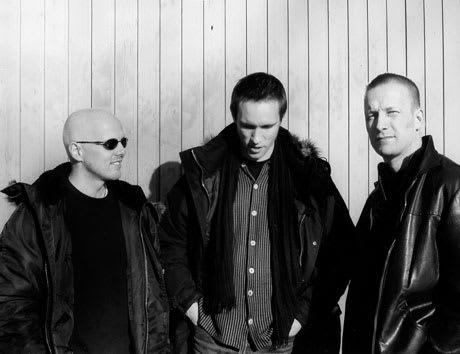Mats Gustaffson, Paal Nilsson-Love and Ingebrit Flaten are happy to spend two days in one city. They are at the tail end of a gruelling North American tour, but you wouldn't know it as this sax/bass/drum power trio basically peeled the paint off the rooms they played in Toronto. Yet, the sound that roared out of this trio is focused and disciplined.
The roles were constantly shifting as Gustafsson's tenor and baritone took on rhythm section duties, framing Nilsson-Love's shattered flow on the drum kit. Bassist Flaten primarily held things together with feedback drones and solid ostinatio figures, at times, taking over for Nilsson-Love's bass drum. Gustafsson did not play a whole lot of notes on these gigs. Considering the fact that he pretty much took a punk rock approach to the music, it's no great surprise. He primarily focused on sound, with sustained wails on bari and tenor that howled and split tones like a Marshall stack on feedback overdrive while reserving the alto for quick, liquid solos.
This gritty approach to sound sculpture within the trio allowed for the bass and drums to establish their own specific space and character within the pieces, which allowed each to shift from complex runs to simple repetitive figures. The fluidity of exchange the trio engaged in spoke volumes about the values of doing what is necessary to allow the music to emerge - that being the willingness of all to engage in simultaneous accompanying and lead roles.
The rock simile was also not lost on the repertoire with tunes by the Sonics and the Ex sharing the stage with references to Sonny Rollins' "St. Thomas" and "Soy Califa," as well as Ornette's "Dancing in Your Head" and what Gustaffson referred to as "hymns" but for all the world sounded like Coltrane's meditative "Alabama."
Gustaffson's ironic asides on continually "trying to find/get at melody" provided an amusing yet pointed insight into his view on his work in this trio. One might speculate on the idea of creating a unified field of sound that while demanding and intense, still displayed the directness of communication and simplicity of any folk form, be it Swedish folk songs, PJ Harvey or the Stooges, all of which the Thing cover in their repertoire.
Their willingness to take free jazz into the zone inhabited by heavy rock represents a refreshing ideological and aesthetic stance that affirms jazz-based improvisation's traditional ability to accept and translate with integrity, the present as well as the past.
The roles were constantly shifting as Gustafsson's tenor and baritone took on rhythm section duties, framing Nilsson-Love's shattered flow on the drum kit. Bassist Flaten primarily held things together with feedback drones and solid ostinatio figures, at times, taking over for Nilsson-Love's bass drum. Gustafsson did not play a whole lot of notes on these gigs. Considering the fact that he pretty much took a punk rock approach to the music, it's no great surprise. He primarily focused on sound, with sustained wails on bari and tenor that howled and split tones like a Marshall stack on feedback overdrive while reserving the alto for quick, liquid solos.
This gritty approach to sound sculpture within the trio allowed for the bass and drums to establish their own specific space and character within the pieces, which allowed each to shift from complex runs to simple repetitive figures. The fluidity of exchange the trio engaged in spoke volumes about the values of doing what is necessary to allow the music to emerge - that being the willingness of all to engage in simultaneous accompanying and lead roles.
The rock simile was also not lost on the repertoire with tunes by the Sonics and the Ex sharing the stage with references to Sonny Rollins' "St. Thomas" and "Soy Califa," as well as Ornette's "Dancing in Your Head" and what Gustaffson referred to as "hymns" but for all the world sounded like Coltrane's meditative "Alabama."
Gustaffson's ironic asides on continually "trying to find/get at melody" provided an amusing yet pointed insight into his view on his work in this trio. One might speculate on the idea of creating a unified field of sound that while demanding and intense, still displayed the directness of communication and simplicity of any folk form, be it Swedish folk songs, PJ Harvey or the Stooges, all of which the Thing cover in their repertoire.
Their willingness to take free jazz into the zone inhabited by heavy rock represents a refreshing ideological and aesthetic stance that affirms jazz-based improvisation's traditional ability to accept and translate with integrity, the present as well as the past.
